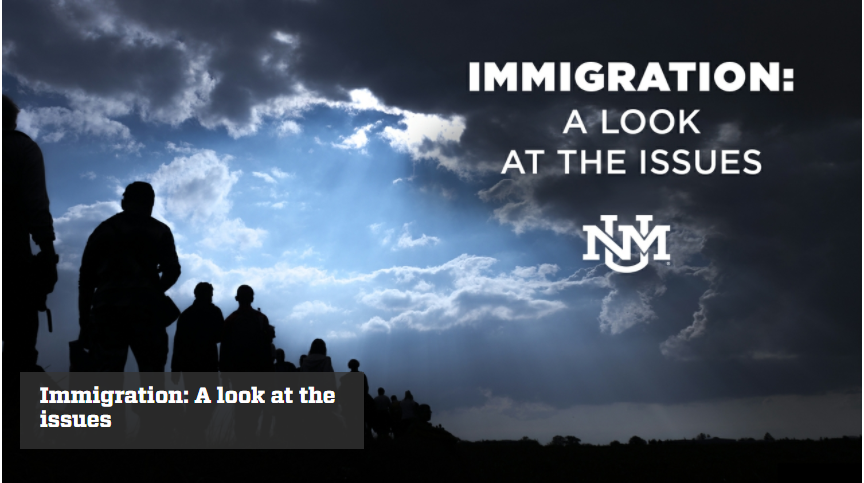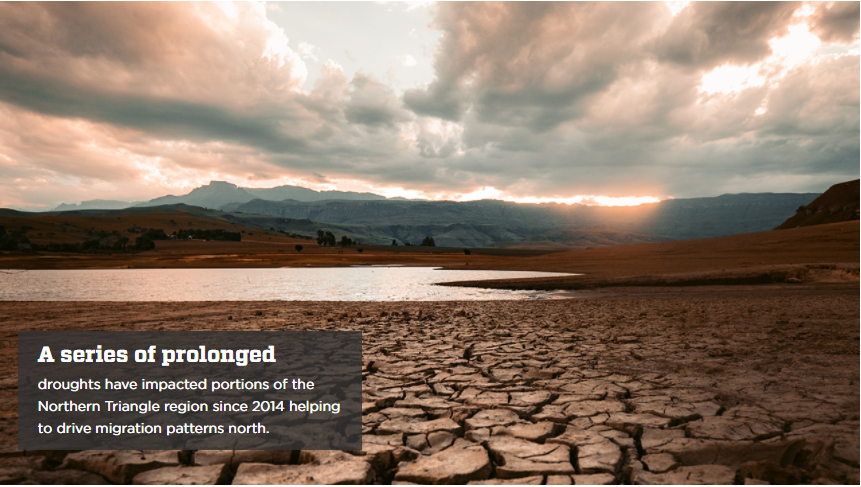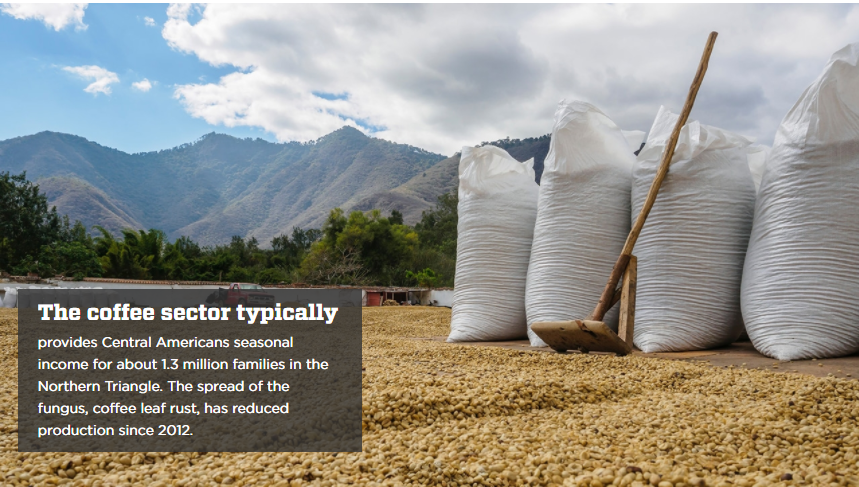Climate change and its impact on immigration
October 13, 2021 - Steve Carr
 Beyond global immigration issues including humanitarian crises and political upheaval, climate change is playing an increasingly relevant role in migration patterns in Central America, the effects of which resonate northward into the United States with little public attention to the climate drivers or the displacement of populations.
Beyond global immigration issues including humanitarian crises and political upheaval, climate change is playing an increasingly relevant role in migration patterns in Central America, the effects of which resonate northward into the United States with little public attention to the climate drivers or the displacement of populations.
Recent research by an international team of scientists suggests a contraction of the Intertropical Convergence Zone (ITCZ) during a warming Earth is leading in turn to the drying of the Neotropics, an area that extends south, east and west from the central plateau including Central America. In turn, this warming is aggravating current trends of social unrest and mass migration.
Positioned near the equator where the trade winds of the northern and southern hemispheres converge, the ITCZ is the world’s most important rainfall belt affecting the livelihood of billions of people around the globe. Globally, seasonal shifts in the location of the ITCZ across the equator dictate the initiation and duration of the tropical rainy season. The behavior of the ITCZ in response to the warming of the Earth is of vital scientific and societal interest.
Led by University of New Mexico Professor Yemane Asmerom, along with co-author and UNM environmental archaeologist Keith Prufer, the international team studied the cause and effect of the current ITCZ contraction.
“In the last seven years there have been mass migrations of people in Guatemala and Honduras – partially driven by political instability, but also driven by drought-related conditions and changes in seasonality,” said Prufer, who has been conducting research in Belize for 25 years. “This is creating enormous problems for agricultural production and feeding a growing population. There is growing evidence that these changes are a direct consequence of climate change.”
Environmental shocks have increasingly worsened the already difficult conditions for food production in the region, which includes the Northern Triangle countries of El Salvador, Guatemala and Honduras. In addition to the ITCZ contraction, other scientific studies have indicated similar results Central America becoming significantly hotter and dryer in recent decades. A series of prolonged droughts have impacted portions of the region since 2014. Additionally, along with the COVID-19 pandemic which had already seen many landless rural families migrating north, Hurricanes Eta and Lota struck the region in 2020 wiping out communities, destroying crops and farmlands, and displacing people already challenged to maintain basic needs.
“In the last five years there have been mass migrations of people in Guatemala and Honduras – partially driven by political instability, but also driven by drought-related conditions and changes in seasonality. This is creating enormous problems for agricultural production and feeding a growing population. There is growing evidence that these changes are a direct consequence of climate change.” – UNM Professor Keith Prufer
Facing repeated crop losses, employment opportunities have also been impacted in the region especially in the coffee sector which typically provides Central Americans a crucial source of seasonal income for about 1.3 million families in the Northern Triangle according to the Congressional Research Service. The spread of the fungus, coffee leaf rust, has reduced production since 2012. Most plantation workers are already landless, having few options to feed families outside of the meager paychecks.
The International Monetary Fund estimates those crises have contributed to annual economic contractions of 8.6 percent in El Salvador, 8 percent in Honduras, and to a lesser degree, 1.5 percent in Guatemala. According to the World Food Program, approximately 8 million people in the Northern Triangle and Nicaragua are facing hunger, including 1.7 million contending with emergency levels of food insecurity. Nearly 15 percent of the people surveyed by the World Food Program in January 2021 reportedly were making concrete plans to migrate, up from 8 percent in 2018.
“People have always been on the move, a feature of humans that has propelled populations to settle in every corner of the earth early in our history,” says Prufer. “Sometimes these movements were in response to change that facilitated growth and innovation, such as early migrations that accompanied the diffusion of incipient agriculture and farming technologies across continents where it was readily adopted by local foraging populations.
“Other migrations are driven by scarcity, such as in response to severe droughts and resource shortages. In much of the world food production is constrained by seasonal cycles, such as the onset of rainy seasons for farmers or the reliable freezing in the arctic which makes it possible to hunt large mammals. Even small changes in these cycles can have marked impacts on populations.”
Previous work based on limited data suggested a southward migration of the ITCZ in response to global cooling, such as during the Little Ice Age a few hundred years ago. In contrast, modeling and limited observational data seemed to suggest the ITCZ expands and contracts in response to cooling and warming. Which of these scenarios is correct has a huge implication for understanding rainfall variability and its economic and social impacts across the tropics. To resolve these seemingly contradictory alternatives, the authors undertook a paleoclimate reconstruction study from the margin of the ITCZ and combined that with existing data from across the full annual north-south excursion of the ITCZ.
“The implication of this and those regions currently in the margins of the ITCZ are likely to experience aridity with increased warming, consistent with modeling data from Central America. These data have important implications for the rainfall-dependent agriculture system on which millions of people depend for food security." – UNM Professor Yemane Asmerom
“Much of our understanding of ITCZ variability was based on records from South America, especially the Cariaco Basin (Venezuela), which was the gold standard,” explained Asmerom. “But these studies were only able to present half of the picture. As a result, they suggested southward movement of the mean position of the ITCZ during cool periods of Earth, such as during the Little Ice Age, and by implication it shifts northward during warm periods. This would imply regions in the northern margin of the ITCZ, such as Central America would get wetter with a warming climate. This contradicted modeling results suggesting drying as a consequence of warming.”
With two testable hypotheses, Asmerom and his colleagues used 1,600 years of new bimonthly-scale speleothem rainfall reconstruction data from a cave site located at the northern margin of the ITCZ in Central America, coupled with published data from the full transect of the ITCZ excursion in Central America and South America. The combined data elucidate ITCZ variability throughout the Common Era including the warmer Medieval Climate Anomaly and the cooler Little Ice Age. The results of this study are consistent with models suggesting ITCZ expansion and weakening during global periods of cold climate and contraction and intensifying during periods of global warmth.
“The pattern that emerges when all the data across the full transect of ITCZ excursion is supportive of the expansion-contraction model,” said Asmerom. “The implication of this and those regions currently in the margins of the ITCZ are likely to experience aridity with increased warming, consistent with modeling data from Central America. These data have important implications for the rainfall-dependent agriculture system on which millions of people depend for food security. This work highlights the convergence of good science with policy relevancy. It also illustrates the strength of cross-disciplinary collaborative work, in this case international.”
“In the decades and centuries to come, billions of people will migrate in response to rapidly accelerating climate change,” Prufer said. “They will move from coastal to inland regions to escape rising seas, and from low-lying to higher elevation areas to protect themselves from increasing seasonal hurricanes and cyclones. As climate oases experience population growth, others will be forced to flee from overpriced to affordable locales. Similarly, people will migrate from failing to stable societies to escape increasing war and conflict.”
The study titled, “Intertropical Convergence Zone Variability in the Neotropics During the Common Era,” was released last year in Science Advances. In addition to UNM, the research also included scientists from the University of Durham (UK), Northumbria University (UK) and the University of California, Santa Barbara.


View original article on UNM Newsroom here.
